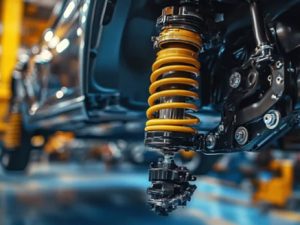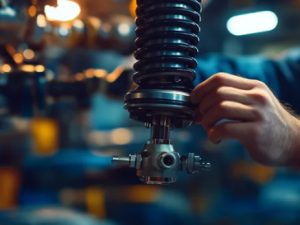Table of Contents
- Understanding Springs in Suspension Systems
- Key Functions of Springs
- Types of Suspension Springs
- Benefits of Properly Functioning Springs
- Signs of Worn-Out Springs
- Maintenance Tips for Suspension Springs
- Replacing Suspension Springs
- Suspension Spring Maintenance Checklist
The suspension system is a vital component of any vehicle, designed to balance comfort and control. At the heart of this system are springs, which play a crucial role in absorbing shocks, maintaining stability, and enhancing the overall driving experience. This article delves into the functions of springs in car suspension, their types, and tips for maintenance and replacement.
Understanding Springs in Suspension Systems

Springs are mechanical devices that absorb and store energy, reducing the impact of road irregularities on the vehicle and its occupants. They work in tandem with other suspension components, such as shock absorbers and control arms, to provide a smooth and controlled ride.
Key Functions of Springs
- Absorbing Shocks: Springs cushion the impact from bumps, potholes, and uneven road surfaces, ensuring a comfortable ride.
- Maintaining Stability: They help distribute the vehicle’s weight evenly, improving handling and reducing body roll during turns.
- Enhancing Traction: Springs keep the tires in consistent contact with the road, which is essential for effective braking and acceleration.
- Load Support: They support the vehicle’s weight and adjust to varying loads, ensuring balanced performance.
Types of Suspension Springs
There are several types of springs used in vehicle suspension systems, each with unique characteristics and applications.
1. Coil Springs
- Description: Made of steel wound into a helical shape.
- Uses: Commonly found in passenger cars and light trucks.
- Advantages: Compact, durable, and provides a smooth ride.
2. Leaf Springs
- Description: Consist of multiple metal strips stacked together.
- Uses: Typically used in heavy-duty vehicles like trucks and SUVs.
- Advantages: Capable of supporting heavy loads.
3. Torsion Bars
- Description: A bar that twists to provide spring action.
- Uses: Found in some cars and light trucks.
- Advantages: Adjustable stiffness and compact design.
4. Air Springs
- Description: Use air-filled rubber bags instead of metal.
- Uses: Found in luxury and performance vehicles.
- Advantages: Adjustable ride height and superior comfort.
Benefits of Properly Functioning Springs

A well-maintained suspension spring system ensures:
- Comfortable Ride: Absorbs road shocks effectively.
- Improved Handling: Maintains stability during cornering and braking.
- Extended Tire Life: Prevents uneven wear by distributing weight evenly.
| Feature | Benefits |
|---|---|
| Shock Absorption | Smooths out road impacts |
| Load Management | Handles varying weights |
| Stability | Reduces body roll and sway |
| Tire Longevity | Ensures even wear |
Signs of Worn-Out Springs
Over time, suspension springs can degrade or fail, compromising safety and comfort. Watch for these symptoms:
- Excessive Sagging: The vehicle sits lower than usual.
- Unstable Handling: Increased body roll or sway.
- Noisy Suspension: Squeaking or clunking sounds over bumps.
- Uneven Tire Wear: Irregular tread patterns.
Maintenance Tips for Suspension Springs
To prolong the lifespan of your springs, follow these maintenance practices:
- Regular Inspections:
- Check for visible cracks, corrosion, or deformation.
- Inspect mounting points and bushings.
- Avoid Overloading:
- Adhere to the manufacturer’s load capacity to prevent undue stress on springs.
- Keep Components Clean:
- Remove dirt and debris from springs to prevent corrosion.
- Replace Worn Parts:
- If you notice signs of wear, replace springs promptly to avoid further damage.
Replacing Suspension Springs
Replacing springs is a technical task best performed by professionals. Here are some key considerations:
- Match Specifications: Use springs compatible with your vehicle model.
- Replace in Pairs: Always replace springs on both sides to maintain balance.
- Use Quality Parts: Opt for durable, high-quality components.
For reliable replacement options, Buy car suspension springs from Elart’s online store.
Suspension Spring Maintenance Checklist
| Task | Frequency | Notes |
| Visual Inspection | Every 6 months | Check for cracks or rust |
| Clean Components | As needed | Remove dirt and debris |
| Replace Worn Springs | As symptoms appear | Use OEM or high-quality parts |
| Avoid Overloading | Always | Prevents premature wear |
Conclusion
Springs are fundamental to a vehicle’s suspension system, balancing comfort and control by absorbing shocks, stabilizing the ride, and enhancing traction. Regular inspections and timely replacements are crucial to maintaining optimal performance and safety. Stay proactive in maintaining your suspension system to enjoy smoother, safer drives.
For high-quality suspension springs and components, explore Elart’s range of car suspension springs. Ensure your vehicle remains in top condition with reliable parts that guarantee comfort and control on every journey.